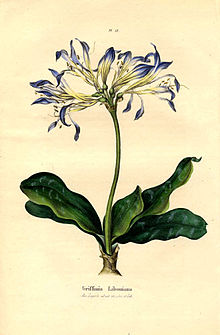

| Griffineae | |
|---|---|

| |
| Griffinia liboniana | |
| Scientific classification | |
| Kingdom: | Plantae |
| Clade: | Tracheophytes |
| Clade: | Angiosperms |
| Clade: | Monocots |
| Order: | Asparagales |
| Family: | Amaryllidaceae |
| Subfamily: | Amaryllidoideae |
| Tribe: | Griffineae Ravenna[1] |
| Type genus | |
| Griffinia | |
| Genera[2] | |
| |

| |
| The tribe Griffineae is endemic to Brazil[3] | |
| Synonyms[4] | |
| |
The Griffineae is a tribe in the family Amaryllidaceae, subfamily Amaryllidoideae. It includes 3 genera with 22 species endemic to Brazil in South America. A typical character of the representatives of the tribe are the flowers - They are blue or lilac and collected into an umbel. Only the members of this tribe and the genus Lycoris are able to form flowers with such color in the whole subfamily Amaryllidoideae of Amaryllidaceae. The species in this group are typically perennial and produce bulbs. The leaves are green, with elliptical form in most of the cases but in some members, as in Worsleya, they are sword-shaped.[5]
The Müller-Doblies' (1996) placed Griffinia in its own subtribe Griffiniinae (of tribe Hippeastreae) and did not recognise Worsleya, which they submerged in Phycella.[4] In contrast, Meerow and Snijman (1998) resurrected it, placing both genera within Hippeastreae.[6] Subsequently, molecular phylogenetic studies demonstrated that Griffineae was a distinct and separate tribe.[7]
The placement of Griffineae within subfamily Amaryllidoideae is shown in the following cladogram, where this tribe is shown as a sister group to the Hippeastreae, forming the Hippeastroid subclade, of two American clades:[3]
| Cladogram: Tribes of subfamily Amaryllidoideae | |||||||||||||||||||||||||||||||||||||||||||||||||||||||||||||||||||||||||||||||||||||||
|
The tribe Griffineae includes the following three genera:[2]
| Griffineae |
|
|---|---|